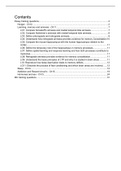Summary
Comprehensive Summary for course Criminality, Cognition and Personality.
- Course
- Institution
- Book
Includes most relevant information you'll need for the exam/resit including: slides used in 2019, Summary of Personality, Personality Disorder, and Violence book, and possible lecturer notes during the lecture.
[Show more]













